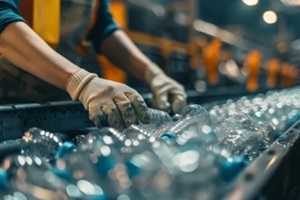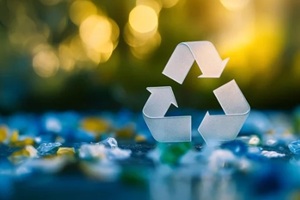September 15, 2025

As recycled plastics gain traction as a core material in packaging and product design, their consistent quality becomes increasingly important.
Global businesses must manage rising expectations, from consumers demanding better sustainability practices to governments imposing stricter regulations. Meeting those expectations depends not just on the availability of recycled plastics but on the reliability and quality of those materials throughout the plastic supply chain.
Uniform quality begins with minimizing potential contamination. When recycled plastic contains food residue, labels, or incompatible materials, the results ripple across processing and manufacturing.
These contaminants compromise safety, introduce variability, and erode trust in recycled content as a dependable alternative. Complete contamination reduction protocols, starting at the collection point, help stabilize inputs for downstream processing.
Visual consistency is equally important, especially for consumer-facing packaging. Factors such as color, clarity, and texture influence perception regardless of the material’s performance. Inconsistent hues or cloudy finishes can suggest inferior quality even when safety and function are unaffected.
Adopting visual standards within plastic supply contracts can align expectations and improve end-product presentation, allowing brands to incorporate recycled content without trade-offs in appearance.
As recycled plastics move closer to direct food-contact applications, rigorous testing becomes non-negotiable.
Verification systems for non-intentionally added substances (NIAS) are essential to identify and mitigate residual chemicals introduced during collection or processing. These tests help maintain public trust and allow manufacturers to expand recycled content in sensitive applications.
Compliance with food-contact regulations requires more than a one-time test. It involves continuous monitoring and documentation across each production batch. Establishing clear protocols for verifying safety at each processing stage builds reliability and keeps materials eligible for the widest range of end uses, particularly in tightly regulated markets.
Reliable quality depends on strong infrastructure, beginning with the systems that collect and sort recycled plastics.
Investments in sensor-driven sorting equipment and AI-assisted material identification are transforming recovery rates and improving feedstock purity. These technologies detect polymers with greater accuracy, reducing the mix-ups that lead to discoloration and contamination.
Optimized collection systems also play a major role. Bottle caps, films, and multi-material packaging introduce complexity into recycling streams. Streamlined collection programs, including deposit-return systems and source-separated recycling, reduce contamination at the origin.
To fully realize the potential of recycled plastics, transparency across the plastic supply chain must improve as a whole. Stakeholders and decision-makers need reliable data on where materials originate, how they were sorted, and what processes they’ve undergone.

Establishing a clear origin trail allows organizations to validate that the material satisfies technical and general compliance criteria. When processors can track a bale of plastic back to its collection point and understand its composition, they’re better equipped to produce high-performance recyclates.
Proper documentation at each stage, including collection, sorting, washing, and reprocessing, creates a more predictable input stream and supports claims about material quality and safety.
The patchwork of recycled-content standards worldwide creates confusion and adds complexity to compliance. A harmonized approach would reduce friction for businesses operating across borders and simplify certification processes for recycled material.
Developing a unified compliance framework that outlines consistent quality, testing, and documentation standards can align public policy with market needs. Businesses benefit from predictable rules while policymakers gain confidence that materials labeled as “recycled” meet stringent benchmarks.
Participation in standards-setting bodies and alignment with industry coalitions help shape these frameworks before they become regulatory obligations.
Product and packaging design have an outsized impact on how recyclable a material becomes at end-of-life. Incorporating recyclability parameters early in the design process improves the odds that materials will be recovered and reused at a high quality.
Separation optimization, making it easy to disassemble packaging into monomaterial components, cuts down on both labor and contamination. For example, designing a PET bottle with a detachable label and no adhesive residue makes it easier to process and improves the clarity of the recycled resin.
These changes often require no compromise in branding or performance, just a more collaborative relationship between design and recycling operations.
Modernizing recycling infrastructure is no longer optional for companies aiming to future-proof their plastic supply chains. The upfront capital needed for advanced sorting or food-grade reprocessing facilities pays off through access to higher-quality material and the ability to meet evolving regulatory demands.
Strategic investment in technology, from infrared sorters to closed-loop washing systems, can elevate the overall performance of the recycling system. When paired with workforce development and operational best practices, these investments yield long-term efficiency gains and higher-value end products.

The future of plastics includes recycled content in plastic supply chains that meet high standards of performance, durability, safety, and appearance. That future depends on actionable strategies and industry-wide collaboration to elevate recycled plastic from an alternative material to a primary one.
If you want to stay current on advancements in sustainable plastics or food packaging requirements, consider joining PLASTICS, the Plastics Industry Association. As a member, you’ll gain insights into the latest technologies, participate in recycling initiatives, and actively shape the industry’s future.
From industry-specific events and economic research to sustainability initiatives and advocacy support, PLASTICS equips its members with the tools to lead in a changing market.
PLASTICS and the Future Leaders in Plastics (FLiP) Committee are devoted to supporting and encouraging the next generation of plastics leaders who will play a crucial role in the innovation, technology and future of the plastics industry. FLiP’s mission is to provide young professionals under the age of 40 the exposure, education and resources they need to build lifelong careers in plastics. Want to join? Want to get your employees involved? Email: [email protected]